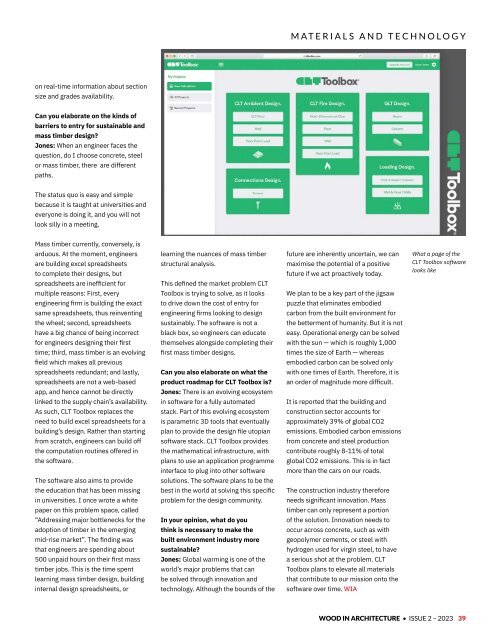WIA_ISSUE2_2023
Create successful ePaper yourself
Turn your PDF publications into a flip-book with our unique Google optimized e-Paper software.
MATERIALS AND TECHNOLOGY<br />
on real-time information about section<br />
size and grades availability.<br />
Can you elaborate on the kinds of<br />
barriers to entry for sustainable and<br />
mass timber design?<br />
Jones: When an engineer faces the<br />
question, do I choose concrete, steel<br />
or mass timber, there are different<br />
paths.<br />
The status quo is easy and simple<br />
because it is taught at universities and<br />
everyone is doing it, and you will not<br />
look silly in a meeting.<br />
Mass timber currently, conversely, is<br />
arduous. At the moment, engineers<br />
are building excel spreadsheets<br />
to complete their designs, but<br />
spreadsheets are inefficient for<br />
multiple reasons: First, every<br />
engineering firm is building the exact<br />
same spreadsheets, thus reinventing<br />
the wheel; second, spreadsheets<br />
have a big chance of being incorrect<br />
for engineers designing their first<br />
time; third, mass timber is an evolving<br />
field which makes all previous<br />
spreadsheets redundant; and lastly,<br />
spreadsheets are not a web-based<br />
app, and hence cannot be directly<br />
linked to the supply chain’s availability.<br />
As such, CLT Toolbox replaces the<br />
need to build excel spreadsheets for a<br />
building’s design. Rather than starting<br />
from scratch, engineers can build off<br />
the computation routines offered in<br />
the software.<br />
The software also aims to provide<br />
the education that has been missing<br />
in universities. I once wrote a white<br />
paper on this problem space, called<br />
“Addressing major bottlenecks for the<br />
adoption of timber in the emerging<br />
mid-rise market”. The finding was<br />
that engineers are spending about<br />
500 unpaid hours on their first mass<br />
timber jobs. This is the time spent<br />
learning mass timber design, building<br />
internal design spreadsheets, or<br />
learning the nuances of mass timber<br />
structural analysis.<br />
This defined the market problem CLT<br />
Toolbox is trying to solve, as it looks<br />
to drive down the cost of entry for<br />
engineering firms looking to design<br />
sustainably. The software is not a<br />
black box, so engineers can educate<br />
themselves alongside completing their<br />
first mass timber designs.<br />
Can you also elaborate on what the<br />
product roadmap for CLT Toolbox is?<br />
Jones: There is an evolving ecosystem<br />
in software for a fully automated<br />
stack. Part of this evolving ecosystem<br />
is parametric 3D tools that eventually<br />
plan to provide the design file utopian<br />
software stack. CLT Toolbox provides<br />
the mathematical infrastructure, with<br />
plans to use an application programme<br />
interface to plug into other software<br />
solutions. The software plans to be the<br />
best in the world at solving this specific<br />
problem for the design community.<br />
In your opinion, what do you<br />
think is necessary to make the<br />
built environment industry more<br />
sustainable?<br />
Jones: Global warming is one of the<br />
world’s major problems that can<br />
be solved through innovation and<br />
technology. Although the bounds of the<br />
future are inherently uncertain, we can<br />
maximise the potential of a positive<br />
future if we act proactively today.<br />
We plan to be a key part of the jigsaw<br />
puzzle that eliminates embodied<br />
carbon from the built environment for<br />
the betterment of humanity. But it is not<br />
easy. Operational energy can be solved<br />
with the sun — which is roughly 1,000<br />
times the size of Earth — whereas<br />
embodied carbon can be solved only<br />
with one times of Earth. Therefore, it is<br />
an order of magnitude more difficult.<br />
It is reported that the building and<br />
construction sector accounts for<br />
approximately 39% of global CO2<br />
emissions. Embodied carbon emissions<br />
from concrete and steel production<br />
contribute roughly 8-11% of total<br />
global CO2 emissions. This is in fact<br />
more than the cars on our roads.<br />
The construction industry therefore<br />
needs significant innovation. Mass<br />
timber can only represent a portion<br />
of the solution. Innovation needs to<br />
occur across concrete, such as with<br />
geopolymer cements, or steel with<br />
hydrogen used for virgin steel, to have<br />
a serious shot at the problem. CLT<br />
Toolbox plans to elevate all materials<br />
that contribute to our mission onto the<br />
software over time. <strong>WIA</strong><br />
What a page of the<br />
CLT Toolbox software<br />
looks like<br />
WOOD IN ARCHITECTURE • ISSUE 2 – <strong>2023</strong> 39

















